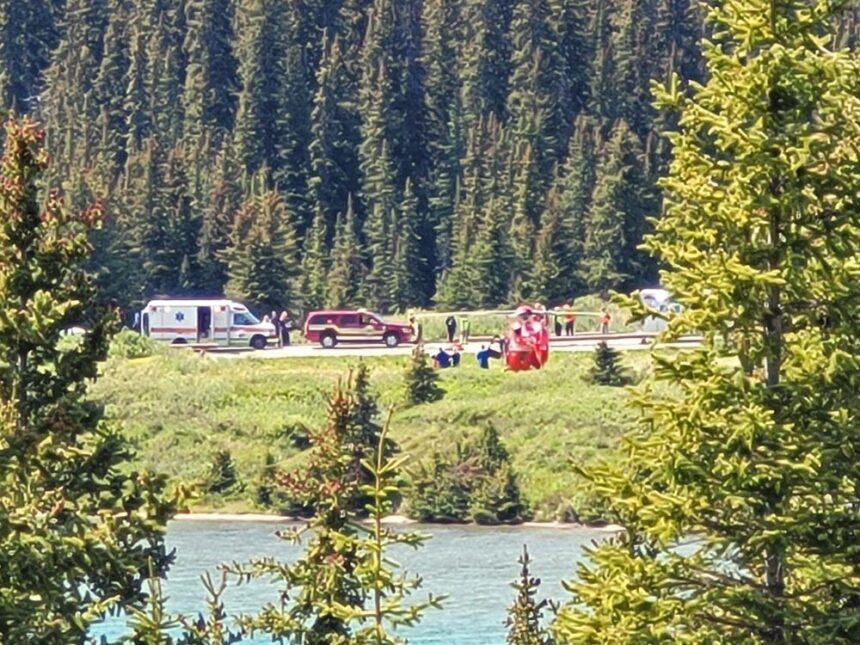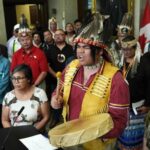The debris cloud was still settling when I arrived at the trailhead near Bow Lake yesterday afternoon. Parks Canada officials had already established a perimeter, their faces grim as they coordinated with mountain rescue teams working against fading daylight.
“We’re dealing with a significant rockslide event,” confirmed Sarah Elmeligi, Senior Ecologist with Parks Canada, as she briefed the small gathering of reporters. “Our priority remains locating and assisting any visitors still in the affected area.”
What began as a pristine summer day in one of Canada’s most iconic national parks turned tragic when a massive section of limestone and shale broke free near Bow Glacier Falls around 2:30 p.m. Tuesday, sending thousands of tons of rock cascading down popular hiking trails. Initial reports suggest between 12-15 hikers were in the vicinity when the mountain face gave way with little warning.
The rockslide marks one of the most serious incidents in Banff National Park in recent years. According to Parks Canada data, while minor slides occur regularly throughout the Rocky Mountain range, events of this magnitude affecting visitor areas remain mercifully rare.
By nightfall, emergency teams had confirmed three hikers with serious injuries had been airlifted to hospitals in Calgary. Five others suffered minor injuries and were treated at the scene. Most troubling, authorities acknowledge they haven’t been able to account for all visitors believed to be in the area.
“We’re utilizing ground teams, helicopter surveillance, and thermal imaging to locate anyone who might be trapped,” said RCMP Constable Teri-Ann Bakker. “The unstable terrain makes this particularly challenging.”
Local wilderness guide Michael Thompson, who has led tours through the area for over two decades, watched the rescue efforts from behind the police line. “These mountains are always changing, always moving,” he told me, his voice heavy. “We’ve had an unusually wet spring followed by intense heat this past week. That combination can be dangerous for rock stability.”
Scientists from the Geological Survey of Canada arrived early this morning to assess ongoing risk. Their preliminary findings suggest the slide was likely triggered by a combination of factors including recent weather patterns and natural erosion processes.
“What we’re seeing is consistent with how climate variability affects high-alpine environments,” explained Dr. Katherine Boggs, geologist with Mount Royal University. “When water penetrates rock fractures and then experiences rapid temperature changes, it creates tremendous pressure. Eventually, something has to give.”
For the Bow Valley communities that depend on summer tourism, the incident represents both a human tragedy and economic concern. Visitor numbers to Banff National Park had finally rebounded to pre-pandemic levels this year, with over 150,000 people entering the park during the last weekend of July alone, according to Tourism Banff data.
Local business owner Jasmine Whyte, who runs a café in nearby Lake Louise, expressed the complicated emotions many are feeling. “We’re devastated for the people hurt or missing,” she said. “At the same time, we worry about visitors cancelling trips because they think the entire park is dangerous.”
Parks Canada has moved quickly to emphasize that the rockslide affected only a small, specific area of the park’s 6,641 square kilometers. Most hiking trails and attractions remain safely accessible.
Minister of Environment and Climate Change Steven Guilbeault issued a statement this morning: “Our hearts go out to those affected by this tragic natural event. We’ve directed all necessary resources to support rescue operations and ensure visitor safety throughout Banff National Park.”
The injured hikers included a family from Edmonton and an international couple visiting from Germany. Privacy protocols prevent releasing their names, but hospital officials describe their conditions as serious but stable.
For those who witnessed the event, the experience remains raw. Calgary resident Daphne Chen had just descended from the falls viewpoint minutes before the slide occurred. “We heard this terrible cracking sound,” she recalled, visibly shaken. “Then it was like thunder that wouldn’t stop. People were running everywhere.”
Chen’s hiking companion captured video that shows an enormous dust cloud rising above the tree line. The footage has been provided to authorities to help pinpoint the exact location and scale of the event.
This morning’s first light revealed the devastating extent of the slide path – a jagged scar stretching nearly 400 meters down the mountainside. Sections of the popular hiking trail have completely vanished beneath massive boulders and shifting scree.
Search operations continue with additional resources arriving from Jasper and Kootenay National Parks. A specialized avalanche rescue team with trained dogs joined efforts shortly after dawn, focusing on areas where signals from mobile phones were last detected.
Alberta Premier Danielle Smith has pledged provincial support for the rescue operation. “We’re monitoring the situation closely and stand ready to provide whatever assistance federal authorities require,” she stated during a press conference in Edmonton.
For now, access to Bow Lake and surrounding trails remains strictly prohibited as geologists continue to monitor for potential secondary slides. Parks Canada has established an emergency information center at the Lake Louise Visitor Centre for those seeking updates on affected areas or concerned about friends and family who may have been hiking in the region.
As this situation continues to unfold, it serves as a somber reminder of nature’s unpredictable power in these majestic but ever-changing mountains that draw millions of visitors each year.






